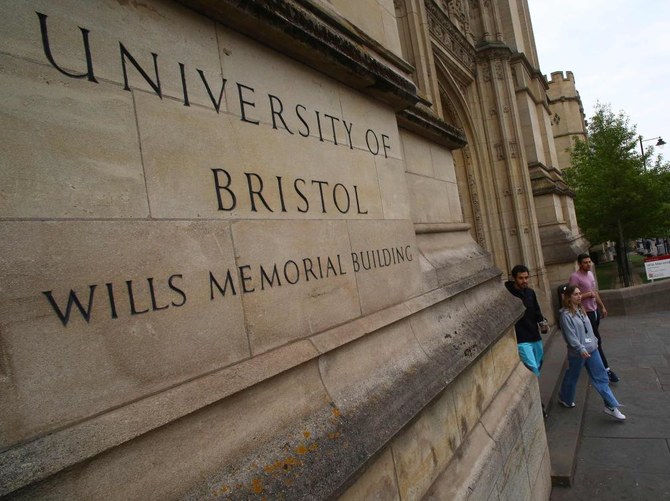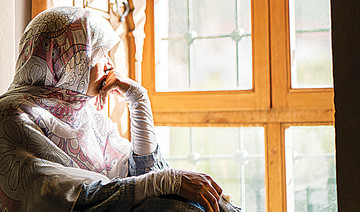LONDON: Former business student Greg used to resort to drink and drugs to get to sleep — a common story at British universities struggling to adapt to growing concerns about student mental health problems.
“I was super, super depressed,” Greg, now aged 26, told AFP.
Around half of the 37,500 students interviewed by The Insight Network, a therapy provider, used drugs and alcohol “as a means of coping with difficulties in their lives.”
One in five reported suffering from mental health issues, mostly depression and anxiety, according to the survey conducted at 140 British universities.
In Greg’s case, it was a combination of factors at play, including the disappointment of not liking his course and coping with having more time on his hands.
The end of a five-year relationship, on top of the death of his grandparents, however, made things even worse, he said, asking not to be identified by his full name.
Dominique Thompson, a doctor who has treated students for 20 years, said their anxiety could be debilitating and was “not about feeling a bit stressed about exams.”
“They would not be able to go out with friends, to go to their lectures, to study, to read... they stop socializing, leaving their room,” she said.
And students with depression sometimes develop “suicidal thinking,” she warned.
Over the last decade, the proportion of British students reporting mental disorders has “significantly increased,” according to a study.
From 0.4 percent in 2008, the figure rose to 3.1 percent last year, the study of nearly 2.3 million students published by the Higher Education Statistics Agency indicated.
However, “we do not know how much of this increase is due to increased awareness of mental health conditions, the willingness of students to report such conditions, or a genuine increase in the prevalence of mental health conditions,” the agency said in written comments to AFP.
Jolted into action, the government announced in March the creation of a new working group “to support students to deal with the challenges” of starting in higher education.
“Our universities are world leading in so many areas and I want them to be the best for mental health support too,” Education Secretary Damian Hinds said at the time.
Students often impose “extremely high, often unrealistic, expectations” on themselves and have difficulty coping with failure, said Andrew Hill, director of a wellbeing research group at York St. John University.
There is also anxiety associated with “seeing mistakes in your work, or that others will spot mistakes you have made,” he told AFP.
Social media, with its visibility and reach, has also contributed to the pressure on young people, said Thompson.
“Cake baking is now a competition, putting on makeup is a competition, sewing, painting, sculpture...
“You name almost anything that could have been fun and relaxing, it’s now become a competition,” she said.
“They’re ... 24/7 under the microscope because of their social media.”
The doctor also said that the rise in student mental disorders was an international phenomenon.
She said students also battled the feeling that it was “no longer enough” to have a university degree because they were now so common.
Another factor can be “helicopter parents,” who micro-manage their children’s busy activity-packed routines while they are still at school, leaving them at a loss once they have to manage on their own, she said.
The experts say that universities need to implement new strategies to help struggling students.
Non-competitive activities just “for fun” should be introduced, as well as teaching students how to deal with failure, said Thompson.
For his part, Hill urged tutors to receive “basic mental literacy training” to “recognize the signs and symptoms” of potential disorders.
Greg remembers asking for help when he was a 20-year-old student at a top London university in 2013, but said that the process took “so long” he gave up.
“They recommended books, numbers to call and asked if I wanted a chat,” he recalled.
“They eventually get back to me between eight and 10 weeks after I contacted them. It was very frustrating.”
Some universities have recently taken up new approaches.
“Like many universities, we tended to focus on the point when they needed additional support,” said Mark Ames, head of student services at the University of Bristol.
Shocked by the suicides of nine of its students since 2016, the institution set up two services, made up of around 60 staff, who “focus on supporting students’ wellbeing,” such as encouraging them to get more sleep.
It is also reviewing how often it tests students and its examinations schedules to “make sure they don’t all bunch at the same time.”
However, it was recently in the headlines after the parents of one of the nine — Natasha Abrahart, 20, a physics student who was found hanged last year — accused the university of failing to do enough.
Birmingham University meanwhile told AFP that it was “actively working” on developing a “single strategic framework,” to replace its case-by-case approach.
Greg said that the approach to mental health at many universities had changed radically since his own experience.
After a five-year “break,” he has returned to university to study geology.
Britain wakes up to student mental health plight
Britain wakes up to student mental health plight

- One in five reported suffering from mental health issues, mostly depression and anxiety, according to the survey conducted at 140 British universities
- The proportion of British students reporting mental disorders has ‘significantly increased’ over the last decade
A 98-year-old in Ukraine walked miles to safety from Russians, with slippers and a cane

- Describing her journey, the nonagenarian said she had fallen twice and was forced to stop to rest at some points, even sleeping along the way before waking up and continuing her journey
KYIV, Ukraine: A 98-year-old woman in Ukraine who escaped Russian-occupied territory by walking almost 10 kilometers (6 miles) alone, wearing a pair of slippers and supported by a cane has been reunited with her family days after they were separated while fleeing to safety.
Lidia Stepanivna Lomikovska and her family decided to leave the frontline town of Ocheretyne, in the eastern Donetsk region, last week after Russian troops entered it and fighting intensified.
Russians have been advancing in the area, pounding Kyiv’s depleted, ammunition-deprived forces with artillery, drones and bombs.
“I woke up surrounded by shooting all around — so scary,” Lomikovska said in a video interview posted by the National Police of Donetsk region.
In the chaos of the departure, Lomikovska became separated from her son and two daughters-in-law, including one, Olha Lomikovska, injured by shrapnel days earlier. The younger family members took to back routes, but Lydia wanted to stay on the main road.
With a cane in one hand and steadying herself using a splintered piece of wood in the other, the pensioner walked all day without food and water to reach Ukrainian lines.
Describing her journey, the nonagenarian said she had fallen twice and was forced to stop to rest at some points, even sleeping along the way before waking up and continuing her journey.
“Once I lost balance and fell into weeds. I fell asleep … a little, and continued walking. And then, for the second time, again, I fell. But then I got up and thought to myself: “I need to keep walking, bit by bit,’” Lomikovska said.
Pavlo Diachenko, acting spokesman for the National Police of Ukraine in the Donetsk region, said Lomikovska was saved when Ukrainian soldiers spotted her walking along the road in the evening. They handed her over to the “White Angels,” a police group that evacuates citizens living on the front line, who then took her to a shelter for evacuees and contacted her relatives.
“I survived that war,’ she said referring to World War II. “I had to go through this war too, and in the end, I am left with nothing.
“That war wasn’t like this one. I saw that war. Not a single house burned down. But now – everything is on fire,” she said to her rescuer.
In the latest twist to the story, the chief executive of one of Ukraine’s largest banks announced on his Telegram channel Tuesday that the bank would purchase a house for the pensioner.
“Monobank will buy Lydia Stepanivna a house and she will surely live in it until the moment when this abomination disappears from our land,” Oleh Horokhovskyi said.
Amazon Purr-rime: Cat accidentally shipped to online retailer

- Galena was found safe by a warehouse worker at an Amazon center after vanishing from her home in Utah
LOS ANGELES: A curious cat that sneaked into an open box was shipped across the United States to an Amazon warehouse after its unknowing owners sealed it inside.
Carrie Clark’s pet, Galena, vanished from her Utah home on April 10, sparking a furious search that involved plastering “missing” posters around the neighborhood.
But a week later, a vet hundreds of miles (kilometers) away in Los Angeles got in touch to say the cat had been discovered in a box — alongside several pairs of boots — by a warehouse worker at an Amazon center.
“I ran to tell my husband that Galena was found and we broke down upon realizing that she must have jumped into an oversized box that we shipped out the previous Wednesday,” Clark told KSL TV in Salt Lake City.
“The box was a ‘try before you buy,’ and filled with steel-toed work boots.”
Clark and her husband jetted to Los Angeles, where they discovered Amazon employee Brandy Hunter had rescued Galena — a little hungry and thirsty after six days in a cardboard box, but otherwise unharmed.
“I could tell she belonged to someone by the way she was behaving,” said Hunter, according to Amazon.
“I took her home that night and went to the vet the next day to have her checked for a microchip, and the rest is history.”
What did people eat before agriculture? New study offers insight

- Analysis of forms — or isotopes — of elements including carbon, nitrogen, zinc, sulfur and strontium in these remains indicated the type and amount of plants and meat they ate
WASHINGTON: The advent of agriculture roughly 11,500 years ago in the Middle East was a milestone for humankind — a revolution in diet and lifestyle that moved beyond the way hunter-gatherers had existed since Homo sapiens arose more than 300,000 years ago in Africa.
While the scarcity of well-preserved human remains from the period preceding this turning point has made the diet of pre-agricultural people a bit of a mystery, new research is now providing insight into this question. Scientists reconstructed the dietary practices of one such culture from North Africa, surprisingly documenting a heavily plant-based diet.
The researchers examined chemical signatures in bones and teeth from the remains of seven people, as well as various isolated teeth, from about 15,000 years ago found in a cave outside the village of Taforalt in northeastern Morocco. The people were part of what is called the Iberomaurusian culture.
Analysis of forms — or isotopes — of elements including carbon, nitrogen, zinc, sulfur and strontium in these remains indicated the type and amount of plants and meat they ate. Found at the site were remains from different edible wild plants including sweet acorns, pine nuts, pistachio, oats and legumes called pulses. The main prey, based on bones discovered at the cave, was a species called Barbary sheep.
“The prevailing notion has been that hunter-gatherers’ diets were primarily composed of animal proteins. However, the evidence from Taforalt demonstrates that plants constituted a big part of the hunter-gatherers’ menu,” said Zineb Moubtahij, a doctoral student in archaeology at the Max Planck Institute for Evolutionary Anthropology in Germany and lead author of the study published on Monday in the journal Nature Ecology & Evolution.
“It is important as it suggests that possibly several populations in the world already started to include substantial amount of plants in their diet” in the period before agriculture was developed, added archeogeochemist and study co-author Klervia Jaouen of the French research agency CNRS.
The Iberomaurusians were hunter-gatherers who inhabited parts of Morocco and Libya from around 25,000 to 11,000 years ago. Evidence indicates the cave served as a living space and burial site.
These people used the cave for significant portions of each year, suggesting a lifestyle more sedentary than simply roaming the landscape searching for resources, the researchers said. They exploited wild plants that ripened at different seasons of the year, while their dental cavities illustrated a reliance on starchy botanical species.
Edible plants may have been stored by the hunter-gatherers year-round to guard against seasonal shortages of prey and ensure a regular food supply, the researchers said.
These people ate only wild plants, the researchers found. The Iberomaurusians never developed agriculture, which came relatively late to North Africa.
“Interestingly, our findings showed minimal evidence of seafood or freshwater food consumption among these ancient groups. Additionally, it seems that these humans may have introduced wild plants into the diets of their infants at an earlier stage than previously believed,” Moubtahij said.
“Specifically, we focused on the transition from breastfeeding to solid foods in infants. Breast milk has a unique isotopic signature, distinct from the isotopic composition of solid foods typically consumed by adults.”
Two infants were among the seven people whose remains were studied. By comparing the chemical composition of an infant’s tooth, formed during the breastfeeding period, with the composition of bone tissue, which reflects the diet shortly before death, the researchers discerned changes in the baby’s diet over time. The evidence indicated the introduction of solid foods at around the age of 12 months, with babies weaned earlier than expected for a pre-agricultural society.
North Africa is a key region for studying Homo sapiens evolution and dispersal out of Africa.
“Understanding why some hunter-gatherer groups transitioned to agriculture while others did not can provide valuable insights into the drivers of agricultural innovation and the factors that influenced human societies’ decisions to adopt new subsistence strategies,” Moubtahij said.
Palestinian prisoner in Israel wins top fiction prize

- The mask in the novel’s title refers to the blue identity card that Nur, an archaeologist living in a refugee camp in Ramallah, finds in the pocket of an old coat belonging to an Israeli
ABU DHABI: Palestinian writer Basim Khandaqji, jailed 20 years ago in Israel, won a prestigious prize for Arabic fiction on Sunday for his novel “A Mask, the Color of the Sky.”
The award of the 2024 International Prize for Arabic Fiction was announced at a ceremony in Abu Dhabi.
The prize was accepted on Khandaqji’s behalf by Rana Idriss, owner of Dar Al-Adab, the book’s Lebanon-based publisher.
Khandaqji was born in the Israeli-occupied West Bank city of Nablus in 1983, and wrote short stories until his arrest in 2004 at the age of 21.
He was convicted and jailed on charges relating to a deadly bombing in Tel Aviv, and completed his university education from inside jail via the Internet.
The mask in the novel’s title refers to the blue identity card that Nur, an archaeologist living in a refugee camp in Ramallah, finds in the pocket of an old coat belonging to an Israeli.
Khandaqji’s book was chosen from 133 works submitted to the competition.
Nabil Suleiman, who chaired the jury, said the novel “dissects a complex, bitter reality of family fragmentation, displacement, genocide, and racism.”
Since being jailed Khandaqji has written poetry collections including “Rituals of the First Time” and “The Breath of a Nocturnal Poem.”
He has also written three earlier novels.
Mexican doctor claims victory in $28 Cartier earrings battle

MEXICO CITY: A Mexican man has claimed a victory over French luxury brand Cartier, saying an error allowed him to buy two pairs of earrings for $28 that were supposed to cost nearly $28,000.
After a four-month struggle, doctor Rogelio Villarreal said he had finally received the jewelry, which he accused the company of refusing to deliver after his online purchase in December.
According to Villarreal, he came across the low-priced earrings while browsing Instagram.
“I swear I broke out in a cold sweat,” he wrote on the social media platform X.
Cartier declined to recognize the purchase and offered Villarreal a refund, as well as a bottle of champagne and a passport holder as compensation, according to a company letter shared by the doctor.
But Villarreal refused and decided to take the case to Mexico’s consumer protection agency, which ruled in favor of the doctor.
Cartier accepted the decision, Villarreal announced.
“War is over. Cartier is complying,” he wrote.


















